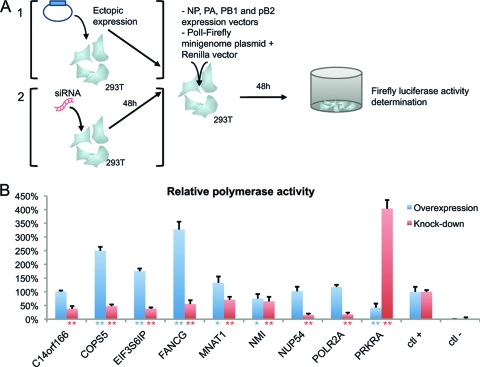Fig. 4.
FluPol-host cell interactors regulate the viral polymerase activity. (A) Schematic representation of the viral polymerase transcriptional activity using a minigenome replicon assay. Human 293T cells were either transfected by a vector encoding the cellular interactor (section 1, overexpression test) or treated with a siRNA targeting the cellular gene (section 2, depletion test). For the overexpression assay (in blue), 293T cells were transfected with a plasmid encoding each cellular protein together with NP, PA, PB1, PB2, a minigenome replicon reporter plasmid coding for firefly luciferase, and a Renilla control vector. Forty-eight hours posttransfection, the luciferase activities were determined. For the depletion assay (in red), 293T cells were first treated with specific siRNAs targeting cellular partners' genes. Forty-eight hours after depletion, cells were transfected with the complete set of vRNP (NP, PA, PB1, and PB2 and the luciferase reporter plasmid) and the Renilla control vector, and the experiment proceeded as for the overexpression test. (B) Results (mean of 2 independent experiments, each performed in triplicate) are expressed as relative effect of overexpression (in blue) or knockdown of FluPol interactors (in red) compared to the control (empty vector for overexpression or scrambled siRNA for depletion). As a negative control (ctl −), cells were transfected with the same reaction mixture without PB1. * and **, P < 0.05 and P < 0.01, respectively, compared to the positive control (ctl +), based on a Student's t test.

